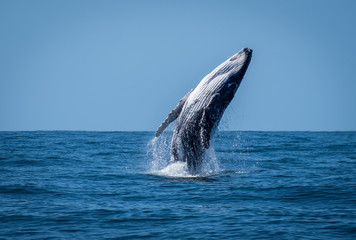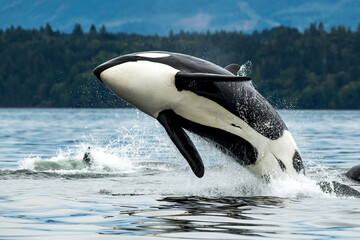Whales are among the most magnificent creatures in the ocean. These giants captivate the hearts and minds of people worldwide with their sheer size, intelligence, and beauty. This article will explore 15 fascinating facts about whales, offering insights into their lives, behaviors, and the critical role they play in our ecosystem.
Table of Contents
Introduction
Whales are a group of marine mammals belonging to the cetacean family, which also includes dolphins and porpoises. They are divided into two suborders: baleen whales (Masticate) and toothed whales (Odontocete). Each suborder has unique characteristics, making these creatures some of the most diverse and fascinating animals in the ocean.
Types
Baleen (Masticate)
Baleen whales have baleen plates instead of teeth. These plates filter food from the water. Some of the well-known species in this suborder include the blue whale, humpback whale, and gray whale.
Toothed (Odontocete)
Toothed whales, as their name suggests, have teeth and are typically smaller than baleen whales. They include species like the sperm whale, beluga whale, and killer whale (orca).
Size and Weight
They are the largest animals on Earth. The blue whale, for instance, can reach lengths of up to 100 feet and weigh as much as 200 tons. In contrast, smaller species like the dwarf sperm whale grow to about 8.5 feet long and weigh up to 600 pounds.
Size Comparison Chart
| Species | Average Length | Average Weight |
|---|---|---|
| Blue Whale | 82-105 ft | 200 tons |
| Humpback Whale | 40-60 ft | 40 tons |
| Orca | 16-26 ft | 6 tons |
| Beluga Whale | 13-20 ft | 1.5 tons |
Diet and Feeding Habits
Baleen

Baleen whales primarily consume small marine organisms such as krill and plankton. They take in large mouthfuls of water and use their baleen plates to filter out their food.
Toothed
Toothed whales have a varied diet that includes fish, squid, and even other marine mammals. The sperm whale is known for diving deep to hunt giant squid.
Communication
Whales communicate using a complex system of sounds. These vocalizations, known as whale songs, can be heard over vast distances underwater. Humpback are particularly famous for their long and intricate songs, which can last for hours.
Migration Patterns
Many species migrate thousands of miles each year. They move between feeding grounds in cold waters and breeding grounds in warmer waters. The gray specie holds the record for the longest migration, traveling up to 14,000 miles round trip.
Migration Route of the Gray
- Feeding Grounds: Bering and Chukchi Seas
- Breeding Grounds: Baja California, Mexico
Lifespan and Aging
Whales have impressive lifespans. The bowhead can live over 200 years, making it one of the longest-living mammals. Other species, like the orca, have an average lifespan of 50-80 years.
Social Structure
They are highly social animals, often found in groups called pods. Orcas, for example, live in tight-knit family groups that cooperate in hunting and protect each other.
Pod Dynamics
- Matriarchal: Many are pods, especially orcas, are led by a dominant female.
- Cooperative Hunting: Pods work together to catch prey, showcasing their intelligence and teamwork.
Breathing and Diving
Whales are air-breathing mammals, surfacing periodically to breathe through their blowholes. They can hold their breath for impressive durations. The sperm whale can dive for up to 90 minutes, reaching depths of over 3,000 feet.
Whale Songs
Purpose of Whale Songs
Whale songs serve various purposes, including mating calls, navigation, and communication. Each species has its own unique set of sounds, and individuals can even have personalized songs.
Humpback Whale Songs
Humpback whales are renowned for their elaborate and melodic songs, which are believed to play a role in attracting mates and establishing dominance among males.
Reproduction
Whale reproduction involves complex courtship behaviors. Female whales typically give birth to a single calf after a gestation period ranging from 10 to 16 months, depending on the species.
Calving
- Calf Birth Weight: Calves of species like the blue whale can weigh up to 3 tons at birth.
- Nursing: Whale calves nurse for several months, consuming rich, fatty milk.
Intelligence and Behavior
Whales exhibit remarkable intelligence, often compared to that of primates. They demonstrate problem-solving abilities, play behaviors, and complex social interactions.
Examples of Whale Intelligence
- Tool Use: Some whales use tools, such as sponges, to protect their snouts while foraging.
- Learning and Culture: Whales can learn from each other and pass down behaviors through generations.
Threats to Whales
Whales face numerous threats from human activities, including:
- Whaling: Despite international bans, some countries continue to hunt whales.
- Pollution: Plastic waste and toxic chemicals in the ocean harm whales.
- Ship Strikes: Collisions with large vessels are a significant threat to many whale species.
- Climate Change: Changing sea temperatures and melting ice affect whale habitats and food sources.
Conservation Efforts

Efforts to protect whales include international treaties, marine protected areas, and advocacy by environmental organizations. Notable initiatives include the International Whaling Commission’s moratorium on commercial whaling and various whale-watching guidelines to minimize human impact.
How You Can Help
- Support Conservation Organizations: Donating to or volunteering with groups like the World Wildlife Fund (WWF) can make a difference.
- Reduce Plastic Use: Minimizing plastic waste helps keep the oceans cleaner.
- Responsible Whale Watching: Choosing eco-friendly tours ensures that your whale-watching experience doesn’t harm these magnificent creatures.

Interesting Facts
- Blue Whale Heart: The heart of a blue whale is the size of a small car and can weigh up to 1,300 pounds.
- Unique Tails: Each humpback whale has a unique pattern on its tail fluke, much like a human fingerprint.
- Speed: The killer whale is one of the fastest marine mammals, reaching speeds up to 34 mph.
- Sleep: Whales sleep by shutting down one hemisphere of their brain at a time, allowing them to surface for air.
- Singing Males: Only male humpback whales sing, primarily during the mating season.
- Longest Recorded Dive: The longest recorded dive of a whale is held by the Cuvier’s beaked whale, which stayed underwater for 138 minutes.
- Milk: Whale milk is extremely rich, with a fat content of up to 50%.
- Whale Fossils: The oldest known whale fossils date back about 50 million years.
- Echolocation: Toothed whales use echolocation to navigate and hunt in the dark depths of the ocean.
- Skin Shedding: Beluga whales periodically shed their outer layer of skin to keep it healthy and clean.
- Spying: Some whales engage in “spyhopping,” where they vertically pop their heads out of the water to look around.
- Bubble Nets: Humpback whales use a technique called bubble net feeding, creating bubbles to trap schools of fish.
- Blubber: Whale blubber provides insulation and energy storage, essential for survival in cold waters.
- Eyesight: Whales have excellent underwater vision and can see well in both bright and dim light.
- Cultural Behaviors: Some whale populations exhibit cultural behaviors, passing down hunting techniques and social rituals through generations.
- Whales, these awe-inspiring marine giants, are an integral part of our planet’s oceanic ecosystem. Their roles extend far beyond what meets the eye, impacting everything from marine food chains to global climate regulation. Let’s delve deeper into various aspects of whale biology, behavior, and their significance in our world.
- Whale Physiology and Adaptations
- One of the most remarkable features of whales is their physiological adaptation to marine life. Despite being mammals, they have evolved to thrive underwater. Their bodies are streamlined for efficient swimming, with powerful tails (flukes) that propel them through the water. Unlike fish, whales move their tails up and down rather than side to side.
- Another significant adaptation is their ability to store oxygen in their muscles. This enables them to dive deep and stay submerged for extended periods. For instance, the sperm whale can dive to depths exceeding 3,000 feet and hold its breath for up to 90 minutes, thanks to a high concentration of myoglobin, an oxygen-binding protein in their muscles.
- Feeding Mechanisms and Diet Diversity
- Whales exhibit a wide range of feeding strategies and dietary preferences. Baleen whales, for example, use their baleen plates to filter small organisms from the water. They often employ a method called lunge feeding, where they accelerate towards a prey cluster with their mouths open wide, engulfing large volumes of water and prey.
- Toothed whales, on the other hand, actively hunt their prey. The orca, or killer whale, is known for its sophisticated hunting techniques, which include coordinated group attacks and beaching themselves temporarily to catch seals. Their diets can vary significantly, from fish and squid to other marine mammals.
- Communication and Social Structures
- Communication among whales is highly advanced. They use a variety of sounds, including clicks, whistles, and complex songs, to convey information. These vocalizations can serve multiple purposes, such as coordinating hunting, navigating, or attracting mates. The song of the humpback whale is particularly famous for its complexity and duration, sometimes lasting for hours and traveling vast distances underwater.
- Whale social structures are equally fascinating. Many species live in pods, which can be matriarchal or patriarchal. These pods are often tight-knit, with individuals forming strong bonds. The social behavior of orcas is a prime example, where pods consist of extended family units that collaborate in hunting and care for their young.
- Role in the Ecosystem
- Whales play a crucial role in the health of marine ecosystems. They contribute to nutrient cycling through their fecal matter, which is rich in iron and nitrogen. This nutrient boost promotes the growth of phytoplankton, the foundation of the marine food web. Phytoplankton not only supports a wide array of marine life but also sequesters significant amounts of carbon dioxide, thus playing a role in regulating the global climate.
- Moreover, whale carcasses provide a substantial food source for deep-sea organisms when they sink to the ocean floor. This process, known as whale fall, creates complex ecosystems that can support life for decades.
- Conservation and Human Impact
- Human activities have significantly impacted whale populations. Historically, whaling was the primary threat, driving many species to the brink of extinction. Although commercial whaling has largely been curtailed, some countries continue the practice under the guise of scientific research or cultural tradition.
- Other ongoing threats include habitat destruction, entanglement in fishing gear, pollution, and climate change. Ocean noise from shipping and industrial activities can disrupt whale communication and navigation, further threatening their survival.
- Efforts to Protect Whales
- Conservation efforts are crucial to ensure the survival of these majestic creatures. International regulations, such as the International Whaling Commission’s moratorium on commercial whaling, have been instrumental. Additionally, marine protected areas provide safe havens where whales can feed, breed, and migrate without human interference.
- Public awareness and education play pivotal roles in conservation. By supporting eco-friendly products, reducing plastic use, and participating in responsible wildlife tourism, individuals can contribute to protecting whales and their habitats. Advocacy and support for conservation organizations also bolster efforts to safeguard these marine giants.
- Understanding the multifaceted lives of whales deepens our appreciation for these remarkable animals. From their intricate social structures and communication methods to their essential ecological roles, whales are far more than just ocean giants. They are vital to the health of marine ecosystems and, by extension, the entire planet. Protecting them is not just about preserving a species but about maintaining the balance of nature that supports all life on Earth.
In conclusion, whales are extraordinary creatures that play a vital role in the marine ecosystem. By understanding and appreciating these 15 facts about whales, we can contribute to their conservation and ensure these magnificent giants continue to thrive in our oceans. Supporting efforts to protect whales and spreading awareness about their importance is crucial for their survival. Whether through reducing plastic use, supporting conservation organizations, or choosing responsible whale-watching tours, every action counts. Let’s work together to safeguard the future




























































